Survival, Smoking, Physical Activity, Obesity, UV Exposure - Life After Diagnosis Summary Table
Only one measure per topic is displayed in the summary table. A complete set of measures, where they exist, can be found by following the More Information link in the table below.
 |
green - headed in the right direction |
 |
red - headed in the wrong direction |
 |
black - stable or non-significant change (NSC) |
 |
purple - indeterminate |
 |
blue - Healthy People 2030 target |
| Measure Name | Survival | Cancer Survivors and Smoking | Cancer Survivors and Physical Activity | Cancer Survivors and Weight | Cancer Survivors and UV Exposure |
|---|---|---|---|---|---|
| Year Range | 1975-2020 | 1992-2022 | 1997-2022 | 1992-2022 | 2005-2020 |
| Measure |
Five-year relative cancer survival: The proportion of patients surviving cancer 5 years after diagnosis calculated in the absence of other causes of death. The relative survival ratio is defined as the observed survival in the patient group divided by the expected survival of a comparable group from the general population. This ratio represents survivors that are expected if cancer were the only cause of death in the cohort. |
Rates of smoking among cancer survivors are based on the self-reporting of individuals with a cancer history who are interviewed as part of the annual population-based National Health Interview Survey (NHIS). Participants who had smoked at least 100 cigarettes in their lifetime and who, at the time of the interview, reported smoking every day or some days were considered to be currently smoking. |
The percentage of cancer survivors reporting no physical activity are based on the self-reporting of individuals with a cancer history who are interviewed as part of the annual population-based National Health Interview Survey (NHIS). Participants were asked how often they perform light, moderate, or vigorous activity for at least 10 minutes. |
Rates of cancer survivors with obesity are based on the self-reporting of individuals with a cancer history, who are interviewed as part of the annual population-based National Health Interview Survey (NHIS). Weight groups are defined by a measurement called body mass index (BMI), which is calculated by dividing weight in kilograms by height in meters, squared. For most adults, experts consider a BMI of 30 and above as having obesity. |
Rates reported for cancer survivors are based on the self-reporting of individuals with a cancer history who are interviewed as part of the annual population-based National Health Interview Survey (NHIS). |
| Recent Summary Trend | Rising | Falling | Non-Significant Change | Rising | Stable |
| Recent Summary Trend Year Range | 2013-2019 | 2018-2022 | 2018-2022 | 2018-2022 | 2015-2020 |
| Desired Direction | Rising | Falling | Falling | Falling | Rising |
| Summary Graph |
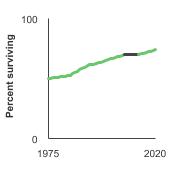
|
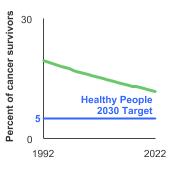
|
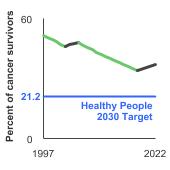
|
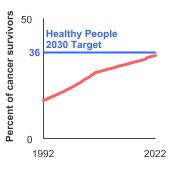
|
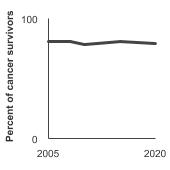
|
| Trends and Most Recent Estimates | For patients diagnosed with cancer in 2015, the 5-year relative survival rate was 71.3%. | In 2022, 11.4% of cancer survivors aged 18 and older currently smoked cigarettes. | In 2022, 36.7% of cancer survivors 18 and older reported no physical activity in their leisure time. | In 2022, 35.9% percent of cancer survivors aged 20 years and older had obesity. | In 2020, 79.2% of adults said they usually or always protect themselves from the sun by practicing at least one of three sun protection behaviors. |
| Healthy People 2030 Target | The Healthy People 2030 Target for survival is pending revisions. This measure will be updated once the Healthy People 2030 target is finalized. | Reduce to 5.0% the proportion of adults who smoke cigarettes. | Reduce to 21.2% the proportion of adults who engage in no leisure-time physical activity. | Decrease to 36.0% percent the proportion of adults with obesity. | No Healthy People Target for this measure. |
| More Information | Survival | Cancer Survivors and Smoking | Cancer Survivors and Physical Activity | Cancer Survivors and Weight | Cancer Survivors and UV Exposure |
| Last Updated | March 2024 | March 2024 | March 2024 | March 2024 | March 2024 |
| Measure Name | Survival |
|---|---|
| Year Range | 1975-2020 |
| Measure |
Five-year relative cancer survival: The proportion of patients surviving cancer 5 years after diagnosis calculated in the absence of other causes of death. The relative survival ratio is defined as the observed survival in the patient group divided by the expected survival of a comparable group from the general population. This ratio represents survivors that are expected if cancer were the only cause of death in the cohort. |
| Recent Summary Trend | Rising |
| Recent Summary Trend Year Range | 2013-2019 |
| Desired Direction | Rising |
| Summary Graph |

|
| Trends and Most Recent Estimates | For patients diagnosed with cancer in 2015, the 5-year relative survival rate was 71.3%. |
| Healthy People 2020 Target | The Healthy People 2030 Target for survival is pending revisions. This measure will be updated once the Healthy People 2030 target is finalized. |
| More Information | Survival |
| Measure Name | Cancer Survivors and Weight |
|---|---|
| Year Range | 1992-2022 |
| Measure |
Rates of cancer survivors with obesity are based on the self-reporting of individuals with a cancer history, who are interviewed as part of the annual population-based National Health Interview Survey (NHIS). Weight groups are defined by a measurement called body mass index (BMI), which is calculated by dividing weight in kilograms by height in meters, squared. For most adults, experts consider a BMI of 30 and above as having obesity. |
| Recent Summary Trend | Rising |
| Recent Summary Trend Year Range | 2018-2022 |
| Desired Direction | Falling |
| Summary Graph |

|
| Trends and Most Recent Estimates | In 2022, 35.9% percent of cancer survivors aged 20 years and older had obesity. |
| Healthy People 2020 Target | Decrease to 36.0% percent the proportion of adults with obesity. |
| More Information | Cancer Survivors and Weight |
| Measure Name | Cancer Survivors and UV Exposure |
|---|---|
| Year Range | 2005-2020 |
| Measure |
Rates reported for cancer survivors are based on the self-reporting of individuals with a cancer history who are interviewed as part of the annual population-based National Health Interview Survey (NHIS). |
| Recent Summary Trend | Stable |
| Recent Summary Trend Year Range | 2015-2020 |
| Desired Direction | Rising |
| Summary Graph |

|
| Trends and Most Recent Estimates | In 2020, 79.2% of adults said they usually or always protect themselves from the sun by practicing at least one of three sun protection behaviors. |
| Healthy People 2020 Target | No Healthy People Target for this measure. |
| More Information | Cancer Survivors and UV Exposure |
| Measure Name | Cancer Survivors and Smoking |
|---|---|
| Year Range | 1992-2022 |
| Measure |
Rates of smoking among cancer survivors are based on the self-reporting of individuals with a cancer history who are interviewed as part of the annual population-based National Health Interview Survey (NHIS). Participants who had smoked at least 100 cigarettes in their lifetime and who, at the time of the interview, reported smoking every day or some days were considered to be currently smoking. |
| Recent Summary Trend | Falling |
| Recent Summary Trend Year Range | 2018-2022 |
| Desired Direction | Falling |
| Summary Graph |

|
| Trends and Most Recent Estimates | In 2022, 11.4% of cancer survivors aged 18 and older currently smoked cigarettes. |
| Healthy People 2020 Target | Reduce to 5.0% the proportion of adults who smoke cigarettes. |
| More Information | Cancer Survivors and Smoking |
| Measure Name | Cancer Survivors and Physical Activity |
|---|---|
| Year Range | 1997-2022 |
| Measure |
The percentage of cancer survivors reporting no physical activity are based on the self-reporting of individuals with a cancer history who are interviewed as part of the annual population-based National Health Interview Survey (NHIS). Participants were asked how often they perform light, moderate, or vigorous activity for at least 10 minutes. |
| Recent Summary Trend | Non-Significant Change |
| Recent Summary Trend Year Range | 2018-2022 |
| Desired Direction | Falling |
| Summary Graph |

|
| Trends and Most Recent Estimates | In 2022, 36.7% of cancer survivors 18 and older reported no physical activity in their leisure time. |
| Healthy People 2020 Target | Reduce to 21.2% the proportion of adults who engage in no leisure-time physical activity. |
| More Information | Cancer Survivors and Physical Activity |